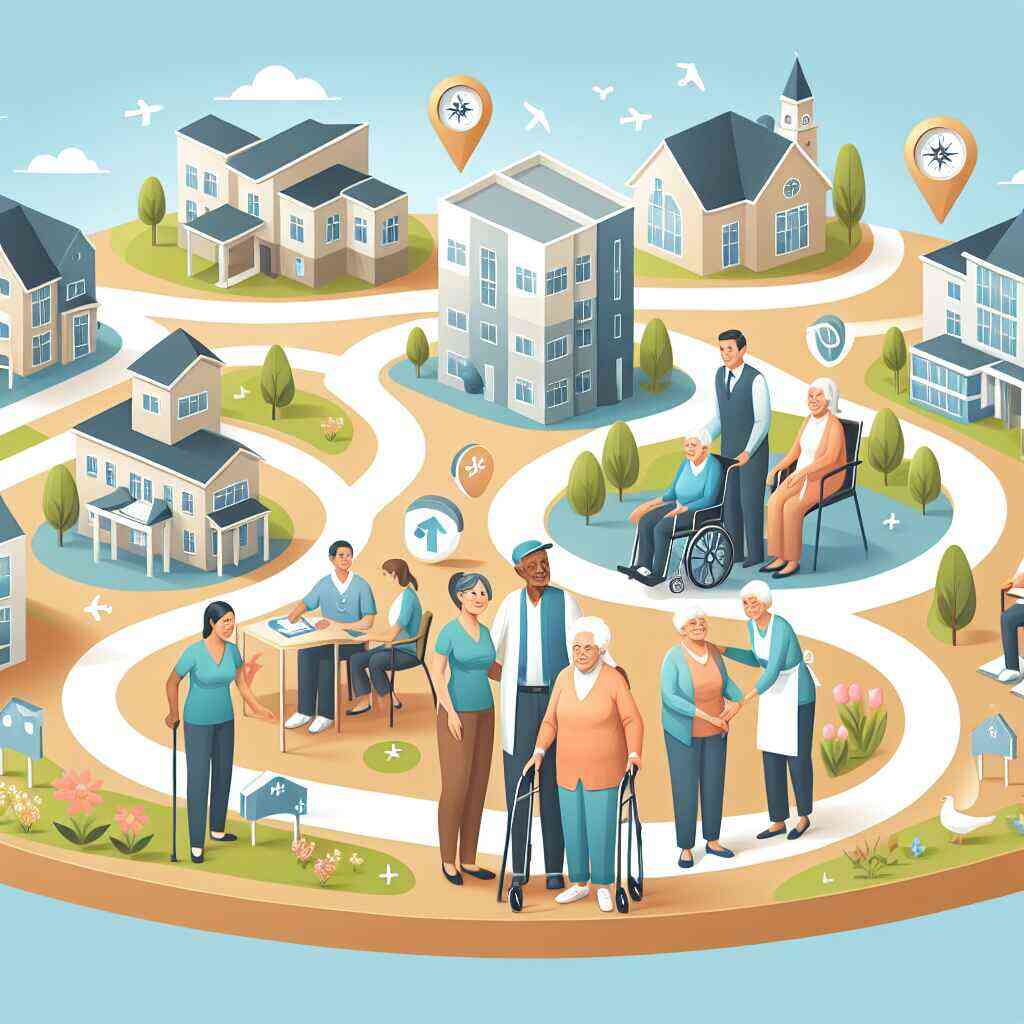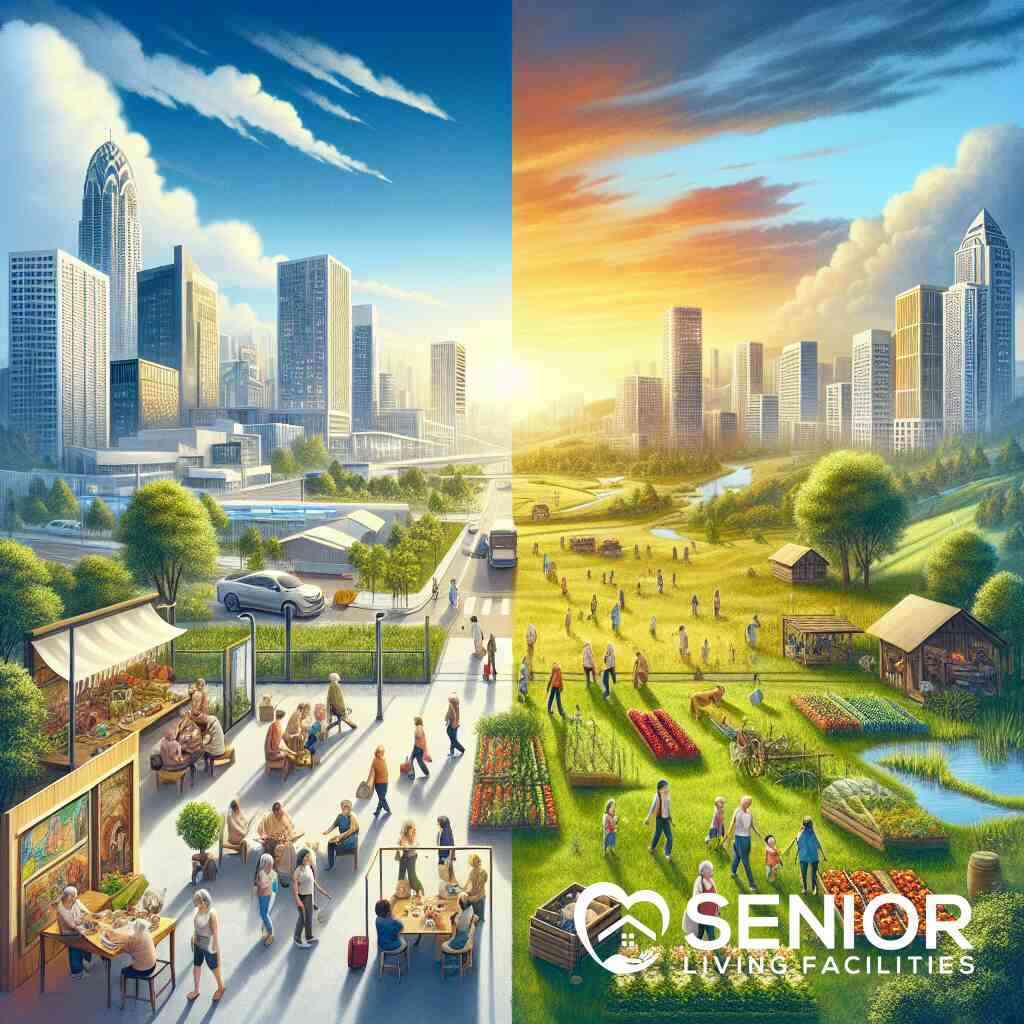
Navigating the Journey to Assisted Living Ease
February 23, 2024
Embracing the Transition
The importance of preparing for assisted living
Embarking on the transition to assisted living is a significant milestone for seniors and their families. It heralds a new chapter that promises enhanced care, a vibrant community atmosphere, and a worry-free lifestyle. Preparing for this change is crucial, not only in practical terms but also emotionally. It involves recognizing the need for more supportive living arrangements and begins with informed research and discussion. To aid in this process, one can start by assessing the current and future needs of the senior. A visit to Senior Living Facilities can offer valuable insights into what to expect and help in navigating assisted living options, ensuring that the transition is as smooth and informed as possible.
Understanding the emotional journey
The path to choosing assisted living involves navigating a spectrum of emotions, from apprehension and grief to hope and acceptance. It’s a process that reflects the natural human response to change, especially one that implicates such a significant life adjustment. Addressing these emotional elements is just as important as sorting the practical aspects. Engaging in open dialogues with family, friends, and professionals can provide the necessary support. Understanding that it’s entirely normal to experience a range of emotions during this time helps in normalizing the experience, making it a bit easier to manage. Support groups and resources offered by senior living communities can also offer comfort and understanding, guiding seniors and their families through these emotional waters.
Making peace with the decision for assisted living
Reaching a state of peace with the decision for assisted living is a journey that requires time, reflection, and often, reassurance. It’s about acknowledging the positive impacts such a move will have on the quality of life for the seniors involved. Through highlighting the benefits, such as access to 24/7 care, opportunities for social engagement, and freedom from daily chores, one can start to view this transition in a more positive light. Additionally, understanding that moving to an assisted living facility does not equate to a loss of independence, but rather, a way to maintain it more safely and enjoyably, can greatly ease the process. The goal is to recognize that this decision is a proactive step towards a fulfilling and vibrant chapter of life, paving the way for acceptance and contentment.
Exploring Assisted Living Options
Differences between senior living facilities and other options
Understanding the array of housing options available for seniors is crucial in making an informed decision. Senior living facilities often provide a blend of residential living, personal care, and health care services designed to respond to individuals who need assistance with normal daily activities in a way that promotes independence. When comparing these facilities to other options like nursing homes, the latter offer more comprehensive medical care to residents with serious health issues. Independent living and retirement communities, on the other hand, cater to seniors who require little to no assistance, focusing instead on providing a community-oriented lifestyle that might include amenities such as clubhouses, gyms, and various social activities. Each option serves different needs and levels of care, emphasizing the importance of understanding one’s requirements before making a choice.
Selecting the right senior living community
Finding the right senior living community requires a multifaceted approach. It’s not just about the level of care but also about the quality of life the community can offer. Consider what matters most to you or your loved one—whether it’s the proximity to family, a specific type of care, or particular amenities and activities. Visiting potential communities, either virtually or in person, and talking to residents and staff can provide invaluable insights. Additionally, it’s beneficial to understand the accreditation and licensing of these facilities, ensuring they meet certain standards of quality and safety. Taking these steps can significantly aid in narrowing down the options to find a community that feels like home.
Key factors to consider when choosing a senior living facility
The journey to selecting the perfect senior living facility revolves around several pivotal factors, each playing a significant role in the final decision. First and foremost, assess the level of care needed, considering how it might evolve over time. This assessment includes looking into the care services provided, such as assistance with activities of daily living, medication management, and on-site medical services.
Another essential factor is the lifestyle and amenities offered. From dining options, fitness programs, to social activities, these features can greatly impact the daily life and happiness of residents. Location is also key, as it affects not just the ease of visits by family and friends, but also the availability of local resources and medical facilities.
Finally, understanding the cost structure and what is included in the fees is critical. This clarity helps in evaluating the affordability of a facility and ensuring it fits within budget constraints without compromising on essential needs. Taking a comprehensive approach to evaluate these factors will lead to a more satisfying and fitting choice for long-term living arrangements.
Identifying Needs and Preferences
Assessing the level of care required
Identifying the right level of care for your loved one starts with understanding their individual needs, both current and potential future ones. This assessment encompasses medical requirements, assistance with daily activities, and even preferences for social interaction. When considering senior living facilities, it is critical to evaluate how well each facility can adapt to evolving care needs. Does the community offer a range of care levels, from independent living to more intensive nursing care? This flexibility ensures that as your loved one’s needs change, they can remain in the same community, minimizing disruption and maintaining continuity in care and social relationships. It’s about finding not just a place to live, but a place to thrive, with the right support at every stage.
Preferences in housing: From senior apartment rentals to nursing homes
After establishing the care requirements, it’s equally important to consider the living situation that will make your loved one happiest and most comfortable. The spectrum of senior housing options is broad, ranging from senior apartment rentals for those who seek independence with minimal care, to full-service nursing homes for those requiring continuous medical attention. Each option caters to different levels of autonomy and care needs. For many, a senior living community that offers apartment-style living with available assistance strikes a perfect balance, providing the freedom of personal space with the security of on-call help. Preferences regarding location, size of living space, and the type of community (for example, those specific to certain hobbies or religious beliefs) should also play a part in the decision-making process.
Importance of amenities in assisted living planning
When envisioning life in a senior living community, the available amenities can significantly influence the quality of life and overall happiness. Assisted living amenities can range from dining services, fitness centers, and recreational programs to wellness services and transportation. These facilities are designed not only to meet the physical needs of residents but also to support their social and emotional well-being. An ideal community should offer a variety of activities and amenities that align with your loved one’s interests and hobbies, encouraging an active and engaged lifestyle. Additionally, amenities like 24/7 security, emergency call systems, and on-site healthcare services add a layer of safety and peace of mind for both residents and their families. Thus, assessing the importance of amenities in the overall planning for assisted living is a step that cannot be overlooked.
Financial Planning for Assisted Living
Understanding the costs of assisted living
The journey towards choosing an assisted living facility often begins with understanding the financial implications involved. The cost of assisted living can vary widely, depending on factors such as location, the type of facility, and the level of care required. Typically, these costs cover housing, utilities, meals, and a set range of services including personal care and transportation. It’s crucial to inquire about what is included in the monthly fee and what services might incur additional costs. By understanding these elements, families can better plan for their financial future, ensuring that they select a living situation that not only meets their loved one’s care needs but also aligns with their financial capabilities. Seeking detailed information from each potential facility and possibly consulting with a financial advisor who specializes in elder care can provide invaluable guidance during this phase.
Exploring affordable senior living options
Discovering affordable senior living options is a significant concern for many families. The notion of finding a high-quality, yet affordable, assisted living facility can seem daunting. However, various avenues can help mitigate these costs and make senior living more accessible. Some facilities offer sliding scale fees based on income, while others may have specific programs designed for veterans or individuals with certain health conditions. Exploring local and state programs that provide financial assistance for senior living can also uncover opportunities to reduce costs. Additionally, some non-profit organizations offer resources and support to seniors seeking affordable housing options. It’s beneficial to conduct comprehensive research and explore all potential avenues for financial assistance and savings, ensuring that the transition to assisted living is not burdened by financial strain.
Navigating insurance and benefits for assisted living
Understanding how insurance and other benefits can affect the costs of assisted living is fundamental in financial planning for this life transition. Often, individuals and families are surprised to learn that Medicare typically does not cover the costs of assisted living. However, other resources, such as long-term care insurance, veterans’ benefits, and certain types of life insurance policies, can offer financial support. Additionally, Medicaid may provide assistance for qualifying low-income individuals, though coverage and eligibility requirements vary by state. It’s important to thoroughly review one’s insurance policies and benefits early in the planning process to ascertain what aspects of assisted living might be covered. Engaging with a financial planner or elder care attorney who has expertise in senior living can also provide clarity and direction, helping families navigate the complex landscape of insurance and benefits. This comprehensive approach ensures that families can make informed decisions, leveraging available resources to secure high-quality care for their loved ones without undue financial hardship.
Using Tools and Resources Effectively
How to use an assisted living locator
In the era of digital convenience, an assisted living locator has become an invaluable tool for families navigating their senior living options. This tool simplifies the process of finding the right senior living community by allowing users to search based on geographic location, type of care needed, budget, and more. To maximize its benefits, start by entering specific needs and preferences, including desired location and care level. The locator then presents a curated list of communities that match these criteria. It’s essential to review each option carefully, paying close attention to the services provided, accommodation types, and overall community atmosphere. Many locators offer direct contact information for each facility, enabling families to schedule visits or ask further questions, thereby making the search for the perfect senior living facility both efficient and tailored to individual needs.
Leveraging online platforms for senior living comparison
Online platforms dedicated to senior living provide a wealth of information that can assist in making an informed decision about assisted living facilities. These websites not only list various senior living options but often feature detailed profiles for each community, including photos, services offered, resident reviews, and pricing information. To effectively leverage these platforms, start by narrowing down choices based on specific criteria such as location, care needs, and budget. Then, delve deeper into each community’s profile, comparing factors like available amenities, the quality of care, and the overall environment. Some platforms also allow for side-by-side comparisons, making it easier to visualize differences and similarities. Remember, the goal is to gather comprehensive data that will aid in choosing the best community for you or your loved one’s needs.
When to seek professional guidance
While online tools and resources provide a solid foundation for understanding assisted living options, there are circumstances when professional guidance becomes crucial. If the process feels overwhelming or if there are specific, complex care needs involved, it might be time to consult with an expert. Professionals such as geriatric care managers, elder law attorneys, and senior living advisors specialize in navigating the intricacies of senior care and can offer personalized recommendations based on comprehensive assessments. Additionally, for families facing difficult decisions around legal, financial, or health care planning, professional guidance ensures that all aspects of the transition to assisted living are managed with expertise and empathy. It’s a step that not only brings peace of mind to families but also ensures that the chosen senior living solution aligns perfectly with individual needs and preferences, paving the way for a smoother adjustment to this new chapter in life.

Making the Move: A Step-by-Step Guide
Organizing and Downsizing for the Move
Making the transition to an assisted living facility often requires a significant amount of organization and downsizing. This process can be emotional and challenging, as it involves letting go of possessions that may have been accumulated over many years. However, it also presents an opportunity for seniors to simplify their lives and focus on what is truly important. Start by categorizing items into what to keep, donate, sell, or discard. For cherished items that won’t fit in the new space, consider gifting them to family or friends. Utilize resources that specialize in senior moves to help make this process more manageable, ensuring that the move to a senior living facility is as stress-free as possible.
The Essentials of a Smooth Transition
Understanding the crucial components for a smooth transition to assisted living is vital. Preparation plays a key role, from the logistics of the move to the emotional preparedness of the senior moving. Assemble a team that might include family members, friends, and professional movers experienced with senior relocations. Inform the chosen assisted living community about the move-in date and any special requirements. Additionally, maintaining open communication with the senior making the transition is critical—they should feel supported and assured throughout the process. A well-thought-out plan, focusing on both practical and emotional aspects, lays the groundwork for a seamless shift to the new living arrangement.
Setting Up a New Home in a Senior Living Community
Creating a comfortable and personalized space in a senior living community is essential for helping new residents feel at home. Upon selecting the right community, work with the staff to understand the layout of the new living space and what items are provided versus what needs to be brought. Encourage seniors to select personal items that will make their new residence feel familiar, such as photos, a favorite chair, or personal mementos. Furthermore, utilizing interior design strategies that cater to safety and mobility can enhance the living experience. Implementing these strategies not only aids in the physical adjustment to a new home but also supports emotional and psychological well-being, fostering a sense of belonging and contentment in the community.
By embracing these steps in the journey to assisted living, families and seniors can navigate the transition with confidence and ease. Each phase, from organizing and downsizing to establishing a new home, contributes to a smoother adjustment and a more fulfilling experience in the senior living community. Following a detailed guide ensures that every aspect of the move is considered, making the process less daunting and more manageable. With the right preparation and support, moving to an assisted living facility can mark the beginning of an enriching and enjoyable chapter in life.
Adjusting to Assisted Living
Coping with change: Tips for new residents
Transitioning to assisted living is a significant change that can evoke a range of emotions for new residents. It’s essential to acknowledge these feelings and approach the adjustment period with strategies to help ease the transition. First, give yourself permission to grieve the life you’re leaving behind while also remaining open to the new opportunities that assisted living presents. Creating a personal space that feels like home by decorating with favorite items can also offer comfort during this time. Engaging in regular communication with family and friends, including the use of digital tools for video chats, helps maintain important connections and support networks. Additionally, setting small, attainable goals can assist in gradually adapting to the new living environment, making the transition smoother and more manageable.
Building connections in a seniors living community
One of the remarkable advantages of residing in a senior living community is the opportunity to meet and connect with others who share similar life stages and interests. Making new friends and building connections is crucial for emotional well-being and creates a sense of belonging within the community. Start by introducing yourself to neighbors and participating in welcome activities organized by the facility. Most communities offer a variety of social events, clubs, and classes that cater to diverse interests—taking part in these can help you discover common interests with fellow residents. Remember, many of your neighbors are likely navigating similar feelings of adjustment, so reaching out can lead to mutually supportive friendships.
Engaging in community activities for social fulfillment
Assisted living communities are designed to provide not just care, but also a rich, fulfilling social environment. Engaging in the array of activities offered can significantly enhance your quality of life. From art classes and music sessions to fitness classes and group outings, these activities encourage social interaction and personal growth. Participation also fosters a sense of achievement and belonging, contributing to overall happiness and satisfaction. Moreover, many communities tailor their programs to the interests and feedback of their residents, ensuring that there’s something for everyone. Don’t hesitate to suggest new activities or clubs that align with your hobbies; it’s another way to make meaningful connections and enrich your experience in assisted living.
Ensuring Ongoing Support
Embracing a new chapter in a senior living community is a significant transition for seniors, necessitating ongoing support. This encompasses maintaining ties with loved ones, leveraging available elder care resources, and adapting care plans to meet evolving needs.
Maintaining communication with family and friends
Central to a senior’s well-being is the continuity of relationships with family and friends. Advancements in technology have made staying connected more accessible than ever, offering various platforms for video calls, instant messaging, and social media to share moments and create new memories. Encouraging regular contact not only aids in combating feelings of isolation but also reinforces the emotional support network crucial for adapting to changes. Communities for seniors 55+ typically facilitate these connections through organized family events and by providing tech support to residents less familiar with digital communication tools, ensuring that keeping in touch remains a joyful and effortless part of daily life.
Accessing resources for elder care assistance
Navigating the complexities of aging requires a supportive network and access to quality elder care assistance. Senior living facilities offer a plethora of services and resources aimed at enhancing the living experience of their residents. These resources range from health and wellness programs to daily living assistance, personalized to meet individual needs. Moreover, many senior living communities have partnerships with local health care providers and organizations specializing in senior care, ensuring that residents have access to the complete spectrum of care services. Whether it’s through on-site medical staff, referrals to specialist services, or assistance with managing health care benefits, a well-supported living environment empowers seniors to focus on enjoying life without the weight of logistical concerns.
Continuous care planning for changing needs
Continuous care planning is pivotal in addressing the evolving health and personal needs of seniors. As circumstances change, so too should the level of support and care provided. Effective senior living facilities are adept at adjusting care plans in response to the dynamic needs of their residents, thereby ensuring safety, comfort, and optimal health. This approach involves regular assessments and open communication with residents and their families to reassess care needs and preferences. By staying proactive and flexible, senior living facilities can adapt to changes—ranging from the onset of new health conditions to shifts in personal preferences—ensuring that each resident’s experience is as fulfilling and worry-free as possible. This continual reassessment and adjustment safeguard the residents’ ability to thrive within the senior living community, making it possible to view each day with confidence and peace.

Choosing Confidence in Care
Embarking on the journey towards assisted living symbolizes stepping into a phase of life where comfort, care, and community take center stage. Senior Living Facilities stands at the forefront of this transition, blending a commitment to quality care with a foundation of trust and satisfaction. Through understanding and meeting the distinct needs of each senior, we make it our mission to elevate the assisted living experience.
The commitment of Senior Living Facilities to quality care
Senior Living Facilities pledges unparalleled dedication to delivering quality care that resonates with the unique requirements of older adults. Recognizing that the transition to assisted living is a profound life change, we curate communities that are not merely places to live but spaces where seniors thrive. Our facilities span all 50 states, offering a diverse range of senior living options, from cozy apartment rentals to comprehensive long-term care facilities. Our rigorous selection process ensures that each community upholds the highest standards of care, safety, and comfort, so families can choose with confidence.
How personalized senior care enhances living experiences
At the heart of Senior Living Facilities is a belief in the transformative power of personalized care. Understanding that no two seniors are alike, we emphasize customization in every aspect of the living experience. From tailored health and wellness programs to individualized activity schedules, our approach centers on recognizing each resident as a unique individual. This personalized senior care philosophy not only meets the specific care needs of seniors but also nurtures their spirit, promoting a sense of belonging and joy. Personalization elevates the daily lives of residents, making every day not just comfortable but fulfilling.
Looking forward with optimism to senior living
The transition to a senior living community is a move filled with hope and promise. It’s an opportunity to embrace a lifestyle that balances independence with the assurance of care. At Senior Living Facilities, we understand the emotional and practical nuances of this transition. That’s why we offer resources, support, and guidance every step of the way—from finding the perfect community to settling in and making it home. Our commitment to quality and personalization ensures that residents and their families can look forward to this new chapter with optimism, knowing they’ve made a choice that brings peace of mind and enriches their lives.
By choosing Senior Living Facilities, families entrust us with their most precious asset—their loved ones. It’s a responsibility we accept with honor and humility, committed to providing an assisted living experience that exceeds expectations. Through the meticulous selection of communities, a focus on personalized care, and the fostering of an optimistic outlook, we stand by our promise to make the journey to assisted living a monument to confidence and assurance in the exceptional care we champion.


